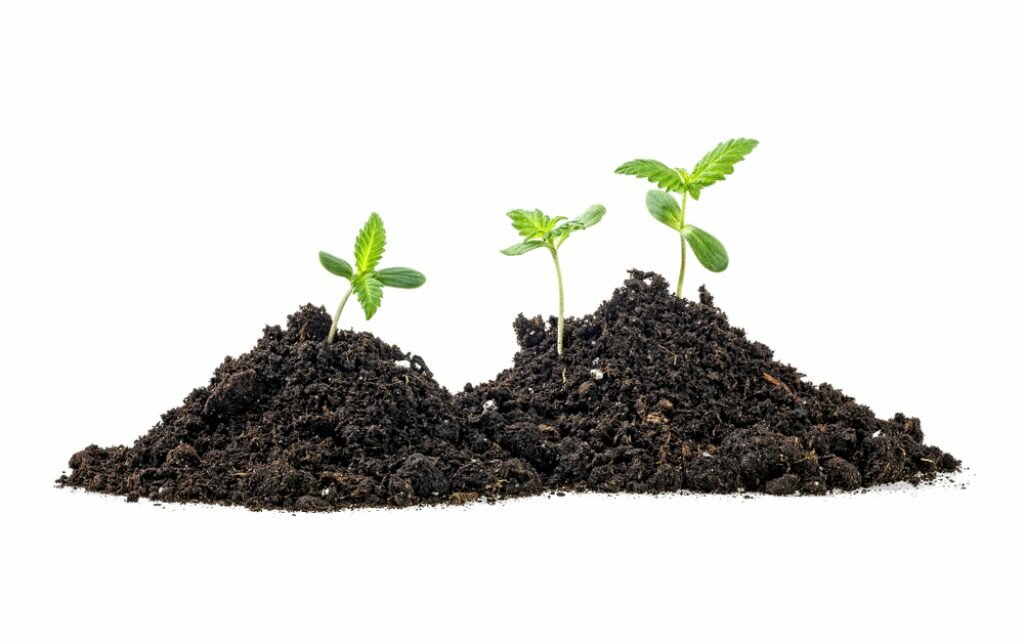Land phytoremediation and cannabis
The process of restoring contaminated lands to utility is called remediation. The use of microorganisms, fungi and plants is nothing new. Some organisms, such as common sea thrift (Armeria maritima), perfectly cope with high concentrations of heavy metals in the soil and easily „pull” them out of the ground [1]. One of the plants better suited for tolerating heavy metals is Cannabis sativa, commonly known as industrial hemp. Its potential usefulness in phytoremediation (remediation using plants, e.g. metallophilic plants) is attributed to the genome of this unique plant [2]. Research shows that it allows the plant to be not only resistant to the harmful effects of high concentrations of such metals as copper, cadmium or nickel, but also to accumulate them in leaves with high efficiency.

Of course, soil contaminated with chemicals can be cleaned without plants. Chemical or physical methods, however, are quite complicated and very expensive. Not to mention, of course, that they often require strong interference with deeper soil layers.
Where is phytoremediation useful?
With increasing anthropogenic soil contamination, phytoremediation can be beneficial for both us, humans, and the wild fauna and flora. Easy-to-grow hemp is perfect for cleaning soils saturated with chemicals due to intensive use of pesticides and phosphorus fertilizers with. These, in many cases, lead to the accumulation of high concentrations of toxic cadmium [3]. This element is also a byproduct of internal combustion engines and (together with other metals) frequent industrial waste. Hemp will therefore prove itself wherever the environment is exposed to this type of pollution.
In addition, cannabis, which in many places is considered simply a rapidly growing weed, can help fighting contamination after nuclear disasters. Such use was helpful, for example, in Ukraine after the Chernobyl reactor crash. Hemp has been successfully contributing to the remediation of local soils from radioactive elements for over 20 years now.
Why hemp?
Both in Chernobyl and many other contaminated places in the world, other phytoremedians are used alongside cannabis. Why should hemp have the advantage? Three important cannabis characteristics determine this:
- Fast growth and easy cultivation. As we have already mentioned, industrial hemp, colloquially speaking, is a weed. This means that it has relatively low environmental requirements and a wide range of temperature tolerance. In addition, it grows and reproduce quickly. You don’t need to do too much with them, they grow in almost any conditions. Cleaning up a large area of soil takes them very little time.
- Long root system. The vast advantage of cannabis over other phytoremedians is the extensive rhizosphere. The relatively long roots of this plant are able to clean deeper parts of the soil than most plants used for this purpose. Hemp phytoremediation is therefore more comprehensive.
- Small financial outlay. Compared to other remediation methods (and even other plants used in phytoremediation), cannabis cultivation is relatively cheap. In addition, even plants contaminated with elements extracted from the soil can be sold and further used. For specific purposes, of course.
What can we do with contaminated cannabis?
Hemp, which was used to remediate heavily contaminated soils, cannot be used in all sectors where this plant normally finds its use. We can’t make food, supplements or clothes from leaves, stems or seeds with a high content of cadmium, lead or nickel. However, we can sell them as biomass for biofuel production. Contaminated hemp can also be burned in boilers for electricity production or distilled to ethanol.
Be careful here – cannabis, which naturally extracts harmful substances from the ground, can be contaminated unintentionally! Therefore, if we want to take care of our health, let’s choose hemp products from transparent, certified (and preferably organic) cultivations.
Cannabis industry grows strong
In addition to the use of hemp for phytoremediation in contaminated areas, high potential is seen e.g. in the production of hemp filters that could absorb pollutants from water and sewage [4]. This plant gives great hopes for the growing demand for sustainable and ecological solutions. That’s why biotechnology scientists are already working on the genetic modification of cannabis. They want to, among others, intensify the absorption of harmful chemicals. Let’s hope that the plans will be implemented and that our Earth will finally get cleaned a bit.
Sources:
[1] Abratowska A., 2006: Armeria maritima — gatunek roślin przystosowany do wzrostu na glebach skażonych metalami ciężkimi. „Kosmos”, 55, 2–3, 217–227.
[2] Asad S., Shah M. M., Muhammad S., 2015: Phytoremediation Potential of Hemp (Cannabis sativa L.): Identification and Characterization of Heavy Metals Responsive Genes. CLEAN – Soil Air Water, 44, 2.
[3] Salmanzadeh M., 2017: Cadmium accumulation in agricultural soils (Thesis, Doctor of Philosophy (PhD)). The University of Waikato, Hamilton, New Zealand.
[4] Morin-Crini N., Loiacono S., Placet V., Torri G., Bradu C., Kostić M., Crini G., 2018: Hemp-Based Materials for Metal Removal. Green Adsorbents for Pollutant Removal, 1–34.
Jeśli podoba Ci się treść na blogu, możesz podziękować za moją pracę stawiając mi wirtualną kawę:
